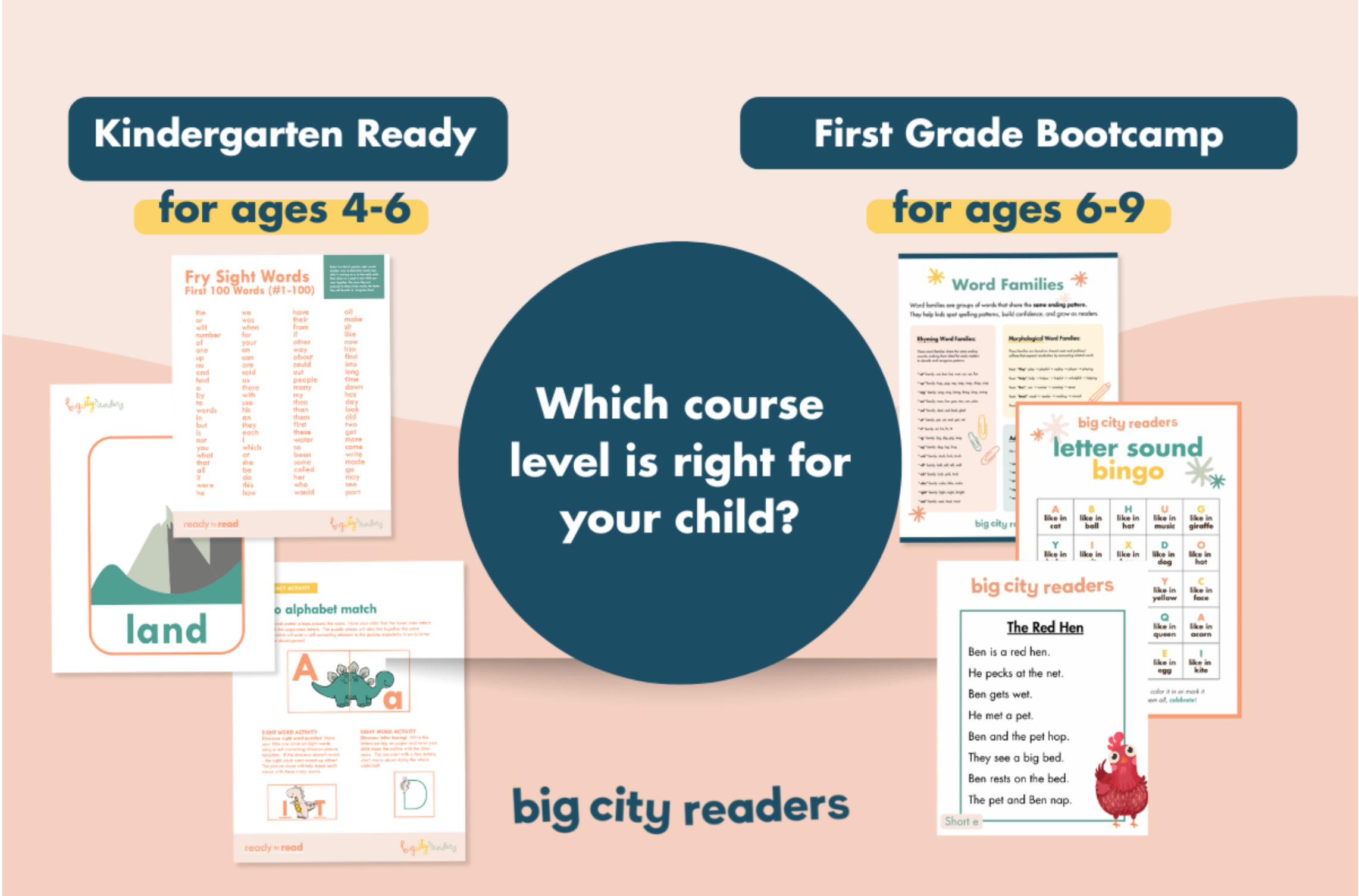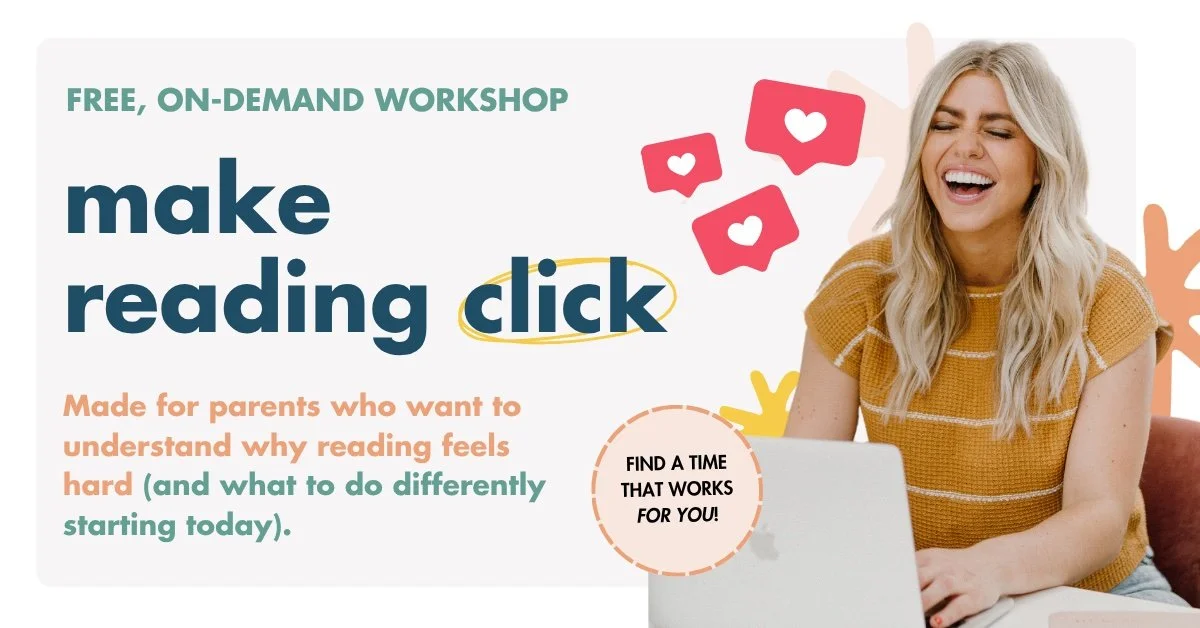What Are Phonograms?
When kids first start learning to read, parents usually hear a lot about letters and sounds. And for good reason; those are the foundation! But once your child knows the sounds letters make, the next big leap is understanding phonograms.
Phonograms are letter combinations that work together to make a single sound, like “sh” in ship or “ea” in meat. Learning them early, often in kindergarten or first grade, helps kids transition from sounding out basic words to confidently tackling longer, trickier ones.
If your child knows the sounds, then spotting patterns like “ch” or “oa” feels natural instead of overwhelming. And suddenly, reading isn’t just about memorizing words, it’s about recognizing the patterns!
Hi! I’m Miss Beth, the founder of Big City Readers. For years, I’ve helped thousands of families raise confident readers using a mix of research-backed strategies, the Orton-Gillingham method, and plenty of play. Here, we don’t just memorize letters; we learn how sounds and patterns work together to unlock the code of reading.
Today, we’re diving into one of my favorite topics: phonograms. What are they, when should kids learn them, and how can you practice them at home in fun, effective ways?
Is Your Child Ready? Quick Check
Before diving into phonograms, make sure your child has these building blocks in place:
✓ My child knows most individual letter sounds (a = /a/, b = /b/, etc.).
✓ My child can blend simple 3-letter words (cat, dog, sit, run).
✓ My child enjoys sound games and recognizes rhyming words.
They’re ready for phonograms! If you checked all three, let's go!
So…What Exactly Is a Phonogram?
The Simple Definition
A phonogram is a written symbol (a letter or group of letters) that represents a sound. Think of it as a building block of words.
Common Examples of Phonograms
The phonogram “sh” makes the sound in ship.
The phonogram “igh” makes the long /ī/ sound in light.
The phonogram “oa” makes the long /ō/ sound in boat.
Phonograms are powerful because they connect what your child hears with what they see on the page.
Instead of memorizing hundreds of individual words (you know how I feel about sight words!), kids can learn these patterns and apply them across many words.
Do Kids Need to Know the Word Phonogram?
It’s not especially important that your child learns the actual word phonogram. What matters is that they understand the idea behind it.
Kids don’t need to point to “sh” and say, “That’s a phonogram.” What they do need is the ability to recognize that certain letters work together to make a single sound like “sh” in ship or “oa” in boat.
For parents, having the term can be helpful because it gives you a way to describe what’s happening when your child is reading. But the real goal is making sure your child sees that words are built from sound patterns, not just single letters.
Once they understand that concept, they can begin decoding words with much more confidence.
Phonograms Feel Like Magic to Early Readers
At Big City Readers, we always say: sounds before letters. Here's why:
Children hear sounds long before they can match them to letters.
Knowing "B" is called "bee" doesn't help a child read bat.
But knowing "b" makes the /b/ sound absolutely does!
Phonograms build on this foundation. Once a child recognizes sounds, they're ready to see how those sounds combine into patterns on the page. That’s when reading truly clicks because they’re connecting something familiar (spoken sounds) with something new (written words).
So fun, right?
When Should Kids Learn Phonograms?
Most children are ready to start exploring phonograms around kindergarten and first grade. That’s when:
They’ve already built a foundation in recognizing letter sounds.
They’re starting to blend sounds into simple words (like CVC words: cat, dog, bat).
Think of it like climbing a staircase:
Step 1: Recognize individual sounds (/m/, /s/, /t/).
Step 2: Blend those sounds into short words (mat, sit).
Step 3: Learn phonograms (th, ch, ee, ai) to unlock longer, more complex words.
A List of Common Phonograms
Here’s a handy list to get you started. These are some of the most useful and frequent phonograms in English:
sh, ch, th, wh
ee, ea, ai, oa, oo
igh, ow, ou, oy, oi
ar, er, ir, or, ur
dge, tch, ck, ng, nk
You’ll notice many of these are digraphs (two letters making one sound) or vowel teams. Together, they cover a huge portion of everyday reading!
Phonograms and the Big City Readers Method
If you’ve been around Big City Readers, you know I love to repeat this: teach the sound, not just the letter. Phonograms fit beautifully into that philosophy.
Kids hear /sh/ before they recognize “sh” on paper.
Once they know the sound, attaching the letters becomes meaningful.
This is how we make reading less about memorization and more about connection.
It’s why our courses, like Kindergarten Ready and First Grade Bootcamp, are filled with activities that bring these patterns to life. We don’t just sit kids at a desk with worksheets. We play with sounds, explore patterns, and show kids how to crack the code of reading in a way that sticks.
Kindergarten Ready → Build classroom confidence with letter recognition, early math, social-emotional development, and foundational reading/writing.
First Grade Bootcamp → Strengthen reading, writing, and math skills while building confidence to take on first grade.
What If My Child Isn’t Ready Yet?
Not every 5-year-old is ready to tackle phonograms, and that’s okay! Kids develop at different speeds. The best indicator isn’t age, but whether your child has:
A solid grasp of individual letter sounds.
The ability to blend those sounds into simple words.
If they’re still working on that, stick with sound games and playful practice. The phonograms will come naturally when the foundation is ready.
Phonograms bridge the gap between knowing letters and reading fluently. When children understand these patterns, they stop guessing at words and start problem-solving instead.
The key is keeping it playful and following your child's pace. Some kids will race through phonograms in a few months, others will take longer, and both are completely normal.
Your Turn: What phonograms has your child started noticing in books or conversations? Drop a comment, I’d love to hear how they’re exploring sounds and patterns at home! Also, check out these other blogs for more fun tips and tricks on early literacy:






In this post, Miss Beth shares practical, play-based strategies to strengthen second grade reading comprehension, so your child can become a confident and curious reader at home and in the classroom.